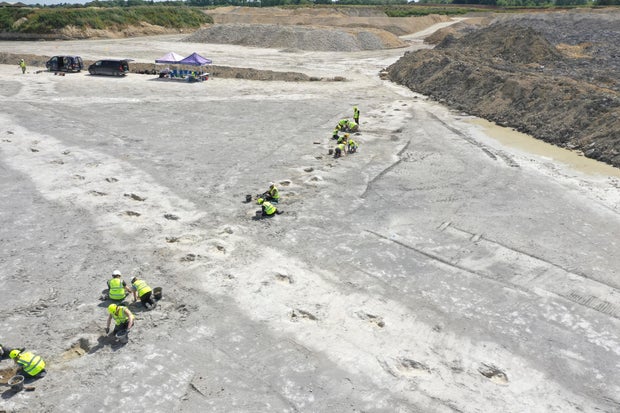British researchers have discovered about 200 dinosaur footprints dating back 166 million years, in a discovery believed to be the largest in the United Kingdom.
Teams from the Universities of Oxford and Birmingham made the “delightful” discovery in a quarry in Oxfordshire, central England, after a worker encountered “unusual protrusions” while stripping clay with a mechanical excavator, according to a new BBC documentary.
Professor Kirsty Edgar, a micropaleontologist from the University of Birmingham, said: “This is one of the most impressive archaeological sites I have ever seen, in terms of the scale, the size of the monuments.” He told BBC News. “You can step back in time and get an idea of what it would have been like to have these huge creatures walking around and going about their business.”
The site features five extensive trails, with the longest continuous trail measuring approximately 500 feet in length.
Four of the five tracks discovered are believed to have been made by a long-necked herbivorous dinosaur, most likely a Cetosaurus.
/AP
The fifth set of tracks likely belonged to a huge nine-metre-long carnivorous dinosaur known for its distinctive three-toed, clawed feet, according to the University of Birmingham.
“It’s rare to find so many in one place, and it’s rare to find such extensive paths too,” Emma Nicholls of the Natural History Museum at Oxford University told AFP.
She added that the area could become one of the largest dinosaur archaeological sites in the world.
The discovery will be featured in a BBC TV documentary “Drilling for Britain”It is scheduled to air on January 8.
A “delightful” discovery.
A 100-strong team led by academics from Oxford and Birmingham excavated the tracks during a week-long excavation in June.
The new tracks follow a smaller discovery in the area in 1997, when 40 clusters were uncovered during limestone quarrying, with some of the tracks reaching 180 meters in length.
The researchers took 20,000 photos of the latest footprints and created detailed 3D models of the site using aerial drone photography.
It is hoped that this discovery will provide clues about how dinosaurs interacted, as well as their size and the speeds at which they moved.
Duncan Murdock, from the Oxford Museum, told the BBC: “To know that this single dinosaur walked across this surface and left exactly that imprint is very exhilarating.” “You can imagine him making his way through, dragging his legs out of the mud as he goes.”
Emma Nicholls/AP
Richard Butler, a paleontologist from the University of Birmingham, said that certain weather conditions may be the reason why the relics are so well preserved.
He added: “We don’t know exactly… but maybe there was a storm that happened, and it deposited a load of sediment on top of the footprints, meaning they were preserved rather than just washed away.” He said.
Quarry worker Gary Johnson, whose vigilance got the excavation started, said the experience had been amazing.
He added: “I thought I was the first person to see them. It was very surreal, and a bit of a painful moment, really.” He told BBC News.
The discovery was announced just months after a team of paleontologists made the discovery Matching dinosaur footprints On what are now two different continents, separated by thousands of miles of ocean.
Last year, engineers working to prevent flooding on a beach in the United Kingdom “dramatic discovery” One of the dinosaur footprints that experts believe is from Mantelisaurus, a type of dinosaur that had only three toes on each foot and moved on its hind legs.
https://assets3.cbsnewsstatic.com/hub/i/r/2025/01/02/37c114ad-665f-4a46-b943-c1164548ff26/thumbnail/1200×630/89a920410314e66812aff0087ce92584/ap25002465581569.jpg?v=fa9977353833f46f40b07abcd9d5240b
Source link

